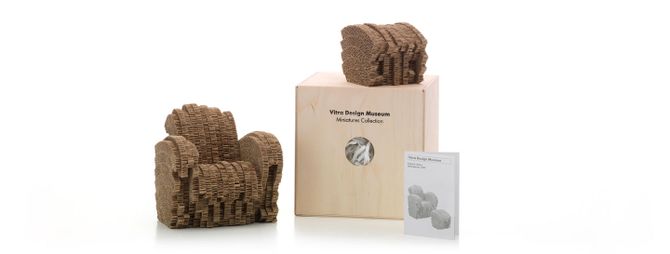
Miniatures Collection - Little Beaver
Frank Gehry, 1986
Gehry chose a different method, which gave birth to sturdy cardboard furniture like carboard sculptures: »One day I look in my office at a pile of corrugated cardboard, the material I normally used to make architecture models, and I began to experiment with it, to stick it together and to cut it into shape with a hand saw and a penknife«. Following his »Easy Edges« from 1972, a series of extraordinarily sturdy cardboard furniture with a smooth surface, from the end of the 1970s onwards Gehry once again devoted his attention to the use of corrugated cardboard as a material for making furniture.
»Experimental Edges« was the name given to unusually expansive armchairs and easy chairs with a rough, ragged- looking surface. Strips of thick cardboard usually used as the filling for door leafs were sawn or cut vertically to the corrugation lines and fashioned into solid volumes of varying shapes. Using this method, single items or small series of furniture were created, which were both furniture sculptures and surprisingly comfortable chairs and sofas.
Miniatures Collection
Durante más de dos décadas, el Vitra Design Museum ha hecho réplicas en miniatura de las piezas más importantes de su colección. La Miniatures Collection es un compendio de la historia del diseño de mobiliario industrial, desde el Historicismo y el Art Nouveau hasta la Bauhaus y la Nueva Objetividad, desde el Diseño Radical y el Posmodernismo hasta nuestros días. Con un tamaño que es exactamente un sexto del de los originales históricos, las sillas son fieles a la escala y reproducen hasta el menor detalle de construcción, material y color. La autenticidad llega incluso a la veta natural de la madera y a la reproducción de los tornillos y las complejas técnicas artesanales utilizadas. Por este motivo, las miniaturas se han convertido en objetos de colección muy populares y en un material didáctico ideal para universidades, escuelas de diseño y arquitectos.